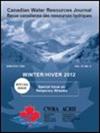局部与大规模洪泛区制图方法的比较分析:以chaudi河为例
IF 0.9
4区 环境科学与生态学
Q3 WATER RESOURCES
引用次数: 2
摘要
洪水是日益威胁社会的自然灾害之一,特别是在当前和未来气候变化的趋势下。目前已经开发了一些工具来帮助规划者管理与洪水相关的风险,包括绘制洪水易发地区的地图,但主要挑战之一仍然是详细数据的可用性,特别是水深测量。本文比较了两种绘制洪水地图的建模方法。这是一种创新的大规模方法,在没有水深数据的情况下,通过1 D/2D水力建模(LISFLOOD-FP),通过对给定流量和给定粗糙度系数的床段进行逆建模来估计。还有一种局部方法,采用详细的1 D/2D耦合水力模型(HEC-RAS),利用河床和洪泛区的所有可用信息(激光雷达和测深)。两种实现都显示了良好的洪峰水位性能值,以及描述洪水面积范围的优秀拟合指数。正如预期的那样,局部方法更准确,但大规模方法的结果非常有希望,特别是在缺乏水深数据和大规模政府计划的地区。本文章由计算机程序翻译,如有差异,请以英文原文为准。
Comparative analysis of local and large-scale approaches to floodplain mapping: a case study of the Chaudière River
Abstract Floods are among natural disasters that increasingly threaten society, especially with current and future climate change trends. Several tools have been developed to help planners manage the risks associated to flooding, including the mapping of flood-prone areas, but one of the major challenges is still the availability of detailed data, particularly bathymetry. This manuscript compares two modeling approaches to produce flood maps. An innovative large-scale approach that, without bathymetric data, estimates by inverse modeling the bed section for a given flow and a given roughness coefficient through 1 D/2D hydraulic modeling (LISFLOOD-FP). And a local approach, with a detailed coupled 1 D/2D hydraulic model (HEC-RAS) that uses all available information at the bed and floodplain (LiDAR and bathymetry). Both implementations revealed good performance values for flood peak levels as well as excellent fit indices in describing the areal extent of flooding. As expected, the local approach is more accurate, but the results of the large-scale approach are very promising especially for areas lacking bathymetric data and for large-scale governmental programs.
求助全文
通过发布文献求助,成功后即可免费获取论文全文。
去求助
来源期刊

Canadian Water Resources Journal
WATER RESOURCES-
CiteScore
2.90
自引率
5.90%
发文量
17
审稿时长
>12 weeks
期刊介绍:
The Canadian Water Resources Journal accepts manuscripts in English or French and publishes abstracts in both official languages. Preference is given to manuscripts focusing on science and policy aspects of Canadian water management. Specifically, manuscripts should stimulate public awareness and understanding of Canada''s water resources, encourage recognition of the high priority of water as a resource, and provide new or increased knowledge on some aspect of Canada''s water.
The Canadian Water Resources Journal was first published in the fall of 1976 and it has grown in stature to be recognized as a quality and important publication in the water resources field.
 求助内容:
求助内容: 应助结果提醒方式:
应助结果提醒方式:


